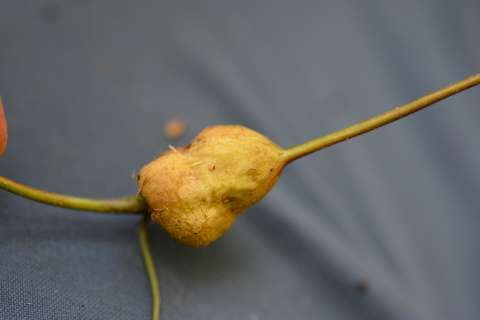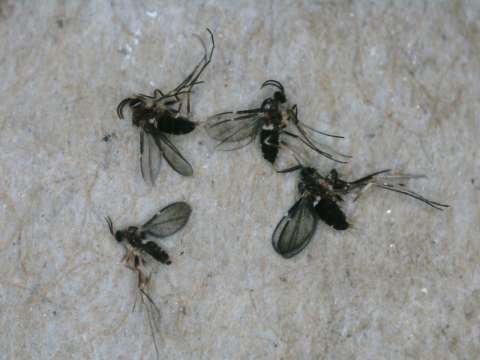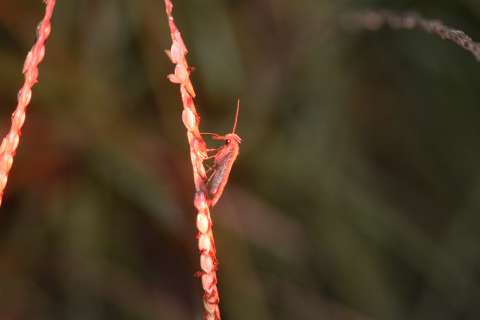Jump To:
Installment #1 - August 2025
Pea vines, controlled tumors, and undiscovered flies at Durant Nature Preserve
Many living things thrive right under our noses without us even noticing. Most of these critters are on the small side. Some are so small we wouldn’t notice them if they were in front of our eyes. Yet others are easy to see, if only we knew what we were looking at. We can sometimes make discoveries if we pay attention to these critters. Some might find it difficult to believe that real mysteries are still out there in an urban Nature Preserve “oasis” like Durant: not wolves, perhaps, but smaller mysteries: species no one has found before, or species no one has found in North Carolina so far, or species about which little is known (except how to recognize them if we see them). I study critters like that in NC, including Durant Nature Preserve, trying to find things that might not catch other people’s attention.
The stems of this plant are normally thin, like the stems to the right and left of the lump in the center. The lump (about 1-2 cm across) is a called a “gall”, which is made by a parasite. What is a gall? I think about it like this: We have chemicals in our bodies (called hormones) that tell us when and how much to grow. Plants also have hormones that serve the same function. Gall-formers are other organisms that make plant hormones, so they can make plants grow for them. Gall formers can make chemicals that mimic plant hormones. They live in the plant tissues, secreting plant chemicals to grow plant parts into shelter and food (plant tissue), sometimes growing continuous food for weeks at a time, while their babies eat the newly growing food and develop inside the galls. When the gall-formers develop into adults, they exit the galls (“drilling” their way out), often flying off to mate and lay eggs on another plant of the right species to start the process again. Galls can be made by some bacteria, fungi, nematodes, and many other organisms. But most gall-formers are insects (wasps, flies, moths, beetles, or aphid relatives) or mites (vegetarian relatives of spiders).
So when I see part of a plant that looks swollen or misshapen, I take a second look. I found a gall like this last year on American Groundnut, but nothing ever emerged from it. When I found this one this summer, I put the gall in a small container with a small piece of damp paper towel, and within a few days, several flies had emerged from the gall into the container:
These are flies in the genus Neolasioptera. Although species in this genus are known for making galls on lots of other plants (each fly species specializing, making galls on only one or a few plant species), no such galls were known on American Groundnut. In August, I sent a male and a female fly to Dr. Ray Gagné, an expert who worked at the Smithsonian Institute (and is retiring, as he is now 90 years old). He confirmed the genus and also said that this is likely to be a species new to science. Yet it takes work to describe a species and to publish that description. Dr. Gagné has his hands full enough with other projects, so unless someone picks up the torch, this species may remain undescribed. Still, now we know a little bit more about this previously unknown species.
When you are out on the trails, keep your eyes open, and your camera ready (and your link to iNaturalist). Who knows when you might come across something most people have not paid attention to before?
This observation is much stranger than it seems. Grasses, by themselves, do not produce nectar. They are usually wind-pollinated, meaning that tiny, light-weight pollen from the male parts of the grass flowers travels on the wind to female parts of other grass flowers of the same grass species. Then, babies are made… but I digress… This means that insects do not usually transfer grass pollen. There is no reason for grasses to attract insect pollinators with nectar, because the wind can do it for them. It would be wasteful to produce nectar. Thus, grasses don’t produce it. End of story? Of course not!
Enter a fungal disease of grasses called Paspalum Ergot, or Claviceps paspali. It infects the flowers of grasses in the genus Paspalum, taking over flowers—the fungus grows into the flowers, eating them and replacing the entire flower with the body of the fungus. While doing this, the fungus uses sugars and other plant materials to make honeydew—a sweet substance like nectar. This honeydew attracts moths and other insects. The honeydew also has fungal spores in it—each spore has the power to make a new fungus on a new grass flower. So insects travel from grass to grass, collecting honeydew, while spreading spores of the fungus.
The story can be more complicated than that—a second fungus (a Fusarium species) parasitizes (eats) the Claviceps fungus, and its spores are carried by moths visiting the Claviceps to get nectar. Also, fungi called endophytes that live inside healthy grass tissues can be carried by moths from grass to grass as they search for nectar. I have seen no evidence of the Fusarium parasite at Durant yet. Also, endophytes are completely unknown at Durant, but I am sure they are there.
Another complication involves chemicals produced by the Claviceps fungus. They produce chemicals that can debilitate mammals if eaten (producing muscle twitches or paralysis, etc.), along with other nasty effects. A relative of these fungi that infects bread (Claviceps purpurea) was even falsely implicated in the Salem Witch Trials…
Does this count as a discovery? Maybe it is a small one. I have found moths on a few species of Paspalum grasses in other places nearby. However, I have not found it at Durant yet. The most interesting parts for me are the discoveries we haven’t made yet. For instance, as far as I know, people do not yet know what attracts the moths to Claviceps-infected grasses. Moths foraging at night are often attracted to fungal smells, like those of yeasts in beer. One moth bait used by people who study moths includes old rotten bananas and stale beer. Some other fungal parasites produce scent to attract insects. So one guess (hypothesis) is that moths are attracted by smell. But this idea hasn’t been tested yet. We also don’t know what affect if any the nectar has on the moths themselves. Does the honeydew made by the fungus help the moths live longer by providing them with more sugar, or does it poison them with weird chemicals that Claviceps fungi are known to produce? Does it help moths in the long run—helping resident moths to make it through the season, or helping migrant moths by fueling their journey?
In addition, some Paspalum species are native, while others are introduced invasive grasses. It isn’t clear how Claviceps paspali affects the grass populations, or how it affects the dynamics between invasive and native grasses.
When you are out on the trails, keep your eyes open, and your camera ready (and your link to iNaturalist). Who knows when you might come across something most people have not paid attention to before?
Reference
Feldman TS, O'Brien HE, Arnold AE. Moths that vector a plant pathogen also transport endophytic fungi and mycoparasitic antagonists. Microb Ecol. 2008 Nov;56(4):742-50. doi: 10.1007/s00248-008-9393-8. Epub 2008 May 20. PMID: 18491176.
I should say before I continue that Charley Eiseman, a leaf miner expert in Massachusetts, and John van der Linden (studies insects inside stems in Iowa) taught me everything I know about these miners. We understand much more about the life cycles of these creatures through the careful work of John van der Linden, who has raised adults from at least one species and has dissected stems to figure out what their paths look like inside stems, where larvae go, and what larvae look like. Still, plenty of mysteries remain.
The first unusual thing about this miner is its habit of switching from mining leaves to mining stems (and potentially back again). The vast majority of leaf-miners are either stem miners or leaf miners, but a few do both. Stem miners (or those that do both) are often more difficult to raise than “straight” leaf miners, as we have to trace their paths down the stems of plants, and hope that they make cocoons in an obvious place on the stem. Some stem-mining moths and flies do just that—they will mine down the stem and then make a pupa case (or cocoon, depending on the species) at the end of their mine, sometimes in a flap of bark they make when they chew a semi-circular exit from their mines. To raise these, we need to look for the ends of the mines at the right time of year (still a challenge). Pseudopostega moths are more challenging than that.
The second unusual thing about Pseudopostega moths is that at some point, their caterpillars mine down the stem into/near the roots and overwinter there. In the spring, the plant sends up new shoots, and the caterpillar mines up into the shoots, completing its development and making a cocoon (somewhere—not sure where). Then the adult moth emerges in mid-late spring. This means that if you collect mined leaves or even plant stems with mined leaves in one season, you will not be able to successfully raise adults (I tried, before I understood the life cycle). You’d have to collect the entire plant—live.
Last season, I tried digging up a couple of plants with mines on leaves and kept them outside (watered) over the winter in net bags. It turns out that it was difficult to see anything emerging from the plant into the bags… and even though at least one plant survived the transplant, it is not clear that the caterpillar(s) survived. This year, I am trying something different. At Durant Nature Preserve, I’ve flagged plants with mined leaves at the bases of their stems. In spring, as new shoots are beginning to develop, I plan to dig up a couple of plants, re-pot them and bag them to see if moths emerge into the bag… I hope this will give me a better shot at catching them, if I maximize the amount of time the larva is spending natural conditions. We’ll see… At least, I might learn something along the way.
References:
Eiseman C., 2019. Leaf Miners of North America https://charleyeiseman.com/leafminers/ (and references therein).
Pseudopostega leaf mines at Durant Nature Preserve: https://www.inaturalist.org/observations/229891925
Pseudopostega stem mines at Durant Nature Preserve: https://www.inaturalist.org/observations/230219591





